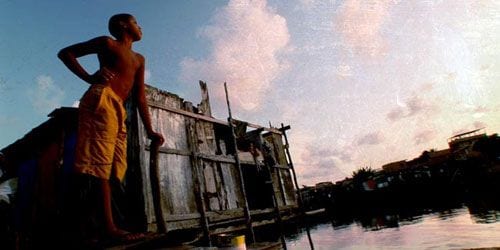
Editor’s note: Winner of the Audience Award for Best Documentary Feature at this year’s SXSW Film Festival, the film is screening on 4 June at the Doc Yard, where it will be followed by a Q&A with filmmakers Annie Eastman and Diane Markrow.
I saw your face in a crowded place,
And I don’t know what to do,
‘Cause I’ll never be with you.
— James Blunt, “You’re Beautiful”
“First it was just the water, and we didn’t have anywhere to live, nowhere to stay. We went to live on top of the water.” As Norato speaks, you see Bahia, Brazil, a city of contrasts. On land, modern apartment buildings stretch up toward a bright blue sky. On the water, in Baía de Todos-os-Santos, people have built homes on stilts, shacks made of cardboard and corrugated tin, leaning precipitously toward the grim grey sea.
That sea, so near the shore, is littered with plastic bottles and bags in 2005, when Bay of All Saints begins. A handheld camera tracks Norato as he walks along a shaky wooden walkway erected over the water, accompanied by a tinny radio sounding “You’re Beautiful.” It’s 2005, and the refrigerator repairman is making his rounds, visiting customers who, he notes, have frequent need of his services. It’s hard to keep appliances running in the palifatas, as these slums on water are known, because water is always seeping in, flooding floors and corroding wires, not to mention the troubles caused by spotty, illicitly accessed electricity.
Most of the homes Norato services are headed by single mothers, women who’ve built the shacks themselves, creating a kind of “land” by filling in the water with garbage. They look after their children and work jobs too; visits from Norato, the camera crew in tow, occasion discussions of daily hopes and disappointments, as well as plans for the future. In between Norato’s conversations, the camera offers glimpses of dogs swimming, kids playing, and dead rats floating in filthy water. This structure is both calculated and revelatory, inviting you to feel both sympathy for residents’ resilience and consternation at their living conditions.
Each of the women Norato calls on has a particular story. Jesus lives with her 15-year-old daughter Rafaela, pregnant and asleep on a sofa, the background TV showing soap operas when you meet her. Jesus worries that her daughter isn’t working (“Teenagers these days are like that, lazy,” she notes, “But you don’t have a mom for your whole life”), and ponders ways to improve their lot; she’s especially concerned once the child is born, that he’ll become sick, surrounded by so much water and mess. Dona Maria is looking after young Rebeca, whose mother was also just 15 when she was born. “I said, ‘I’ll keep this cute little girl,'” remembers Dona Maria, worried she’d be abandoned.
Norato calls Geni “my comrade”: she lives with her young son Roger: when Geni and Norato take him to visit Santa Claus at a store in town, the boy is resolved not to be “afraid.” “I’ll sit in his lap,” he insists. The sight of Santa — bright red suit, in a crowded, well-lit space, emphasizes the “two different worlds” where Geni lives. As Norato explains, she travels a distance each day to provide for Roger, working at a pizzeria in town. Here, Norato points out, people don’t know about the palifatas, as the film shows shoppers making their way along sidewalks, distracted and apparently content. On the water, people don’t have much time to shop.
The film tracks their experiences over several years, as the World Bank allocates $49 million to the state of Bahia in order to “eliminate” slums like that in Bay of All Saints. A local agency, CONDER, comes up with plans to build housing projects, but never quite follows through. The agency holds a couple of meetings with residents, encouraging them with charts and drawings, promising help in relocation and paying rent for actual houses, on land. Geni points out that the planned sites for these projects make it difficult for workers like herself: there’s no bus service to get her from a house outside the city to the pizzeria. She begins to organize, attending community meetings and demonstrations against CONDER, whose ideas about filling in land and making profits have little to do with the people who live on the water.
Jesus makes another choice, to move in with Rafaela and the baby with a man who can support them; when he turns out to be a drunk and abusive, the women need to sort out their priorities. When Norato asks Rafaela if she’s able to live with a man who seems like “Satan” in order to keep her child out of the palifatas. As they look on a clean beach where people in swimsuits frolic in the waves, Rafaela murmurs, “I never want to go back.”
You can understand why, but you can also understand how, as Geni puts it, the shacks seem like “freedom,” ways for single women to live on their own, without depending on untrustworthy men and corrupt institutions, among a community forged out of mutual respect and hard work. Still, she observes, the shacks are costly too. “I always thought this place was mine, it was ours,” she says. “But it wasn’t ever ours. There will be land and it won’t be ours. It will always belong to the water.” It’s a profound and poetic way to frame any number of problems, the water as metaphor and reality.

![Call for Papers: All Things Reconsidered [MUSIC] May-August 2024](https://www.popmatters.com/wp-content/uploads/2024/04/all-things-reconsidered-call-music-may-2024-720x380.jpg)



